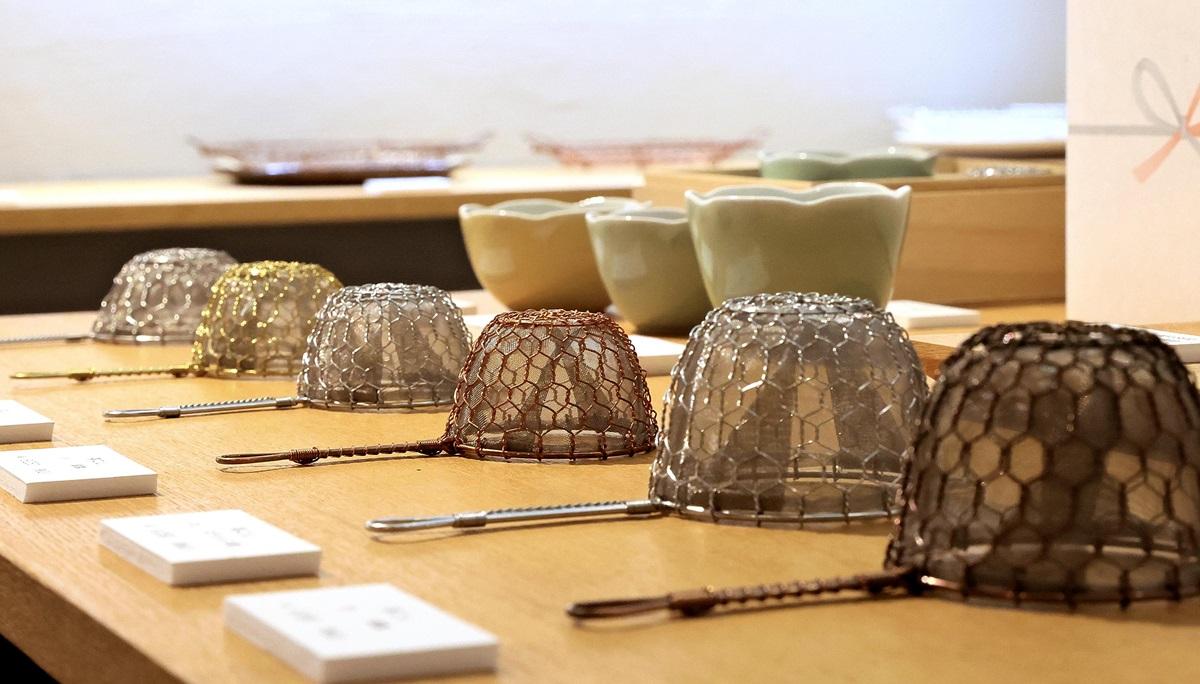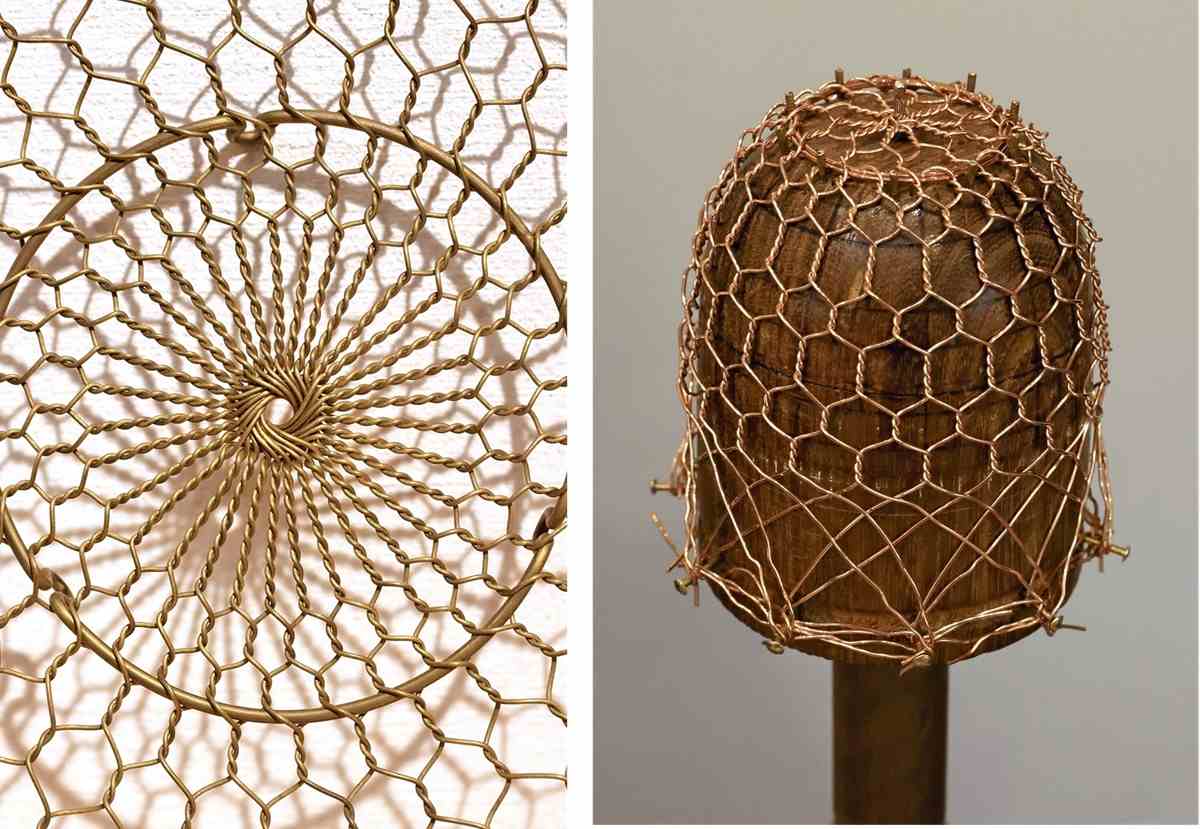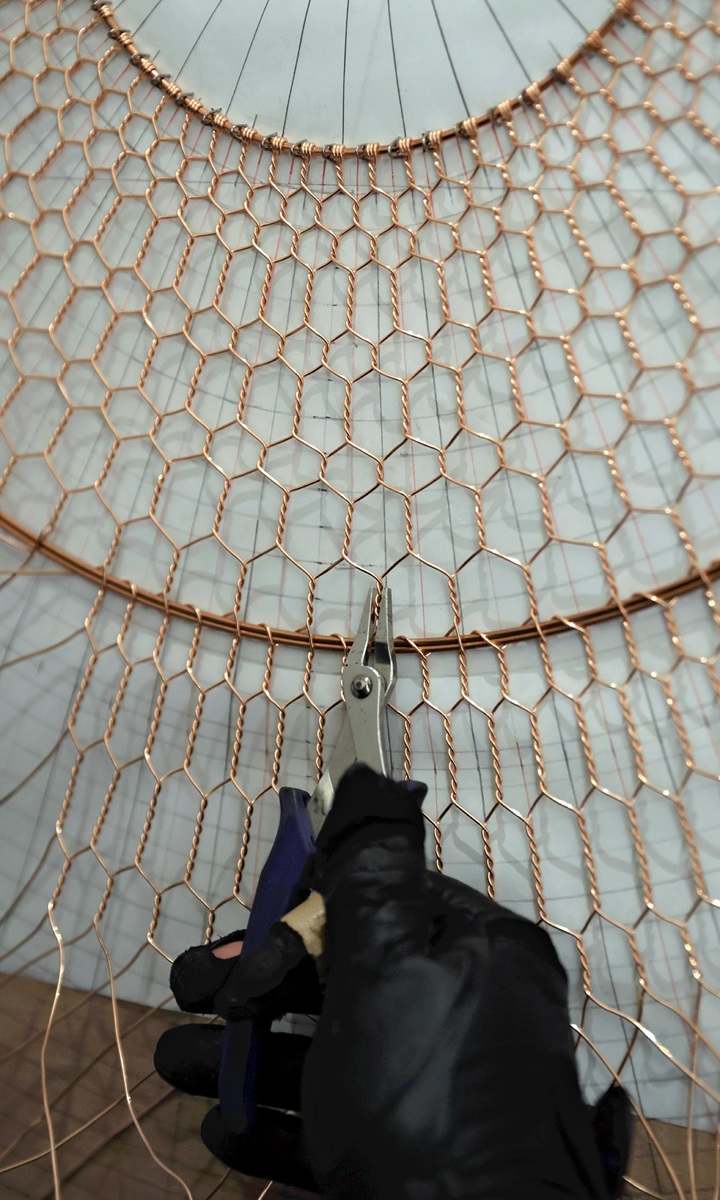Heirs to Kyoto Talent / Artisan Adds Twist to Traditional Metal Weaving; Charming Lampshades, Coffee Drippers Made by Hand

Toru Tsuji hand weaves a piece for a sauna skylight, in Higashiyama Ward, Kyoto.

11:40 JST, April 20, 2024
KYOTO — As he twists together two copper wires, then two more and two more, a woven pattern of shiny metal hexagons takes shape.
Artisan Toru Tsuji produces kitchen utensils and other items by twisting copper or stainless-steel wire in this way at his workshop in Higashiyama Ward, Kyoto. His craft is called Kyo-kanaami.

Tea strainers come in different colors depending on the material they are made from, such as copper or stainless steel.
“I hold my breath when I concentrate on it,” said Tsuji, the second-generation owner of Kanaami-Tsuji, a manufacturer of Kyo-kanaami. He spends as much as ten hours a day on his elaborate pieces.
The art of Kyo-kanaami is said to date back as far back as 1,000 years ago. Tsuji, who has been in the family business for 21 years, makes a variety of Kyo-kanaami products, ranging from such Japanese traditional items as tea strainers, tofu scoopers and sesame roasters to Western goods, including lampshades and coffee drippers.
The traditional handicrafts, woven in chrysanthemum or tortoiseshell mesh patterns, are made with the utmost care and attention to detail. Naturally, they’re beautiful, but they’re also a pleasure to use.

Kanaami-Tsuji’s lampshades have been used in luxury hotels.
A disagreeable business
Kanaami-Tsuji was founded by Tsuji’s father, Kenichi, in Kita Ward, Kyoto, in 1985. According to Tsuji, his parents were so obsessed with their work they never visited his school on class observation days. “Partly because it made me feel lonely, I didn’t want to take over such a consuming business,” he said.
Shunning the family trade, Tsuji worked at a hip-hop clothing store after graduating from high school. His courteous approach to customers helped boost sales, but he left the job after about three years. He also traveled around Jamaica, the birthplace of reggae.
When Tsuji visited his parents’ workshop for the first time in several years after the trip, he was drawn to their honest approach to craftsmanship.
“I felt that it would be more interesting to make products and sell them myself,” Tsuji said. He joined Kanaami-Tsuji when he was 21.
The workshop was then mainly making utensils for cooking and Japanese confectionery stores, and most of the products were sold to wholesalers. But once, when Tsuji was delivering the products, he saw them being treated roughly. He realized he should sell directly to customers, as these were crafts he and the workshop’s other workers had poured themselves into.

Left: A teacup saucer made with various weaving techniques. Right:A wooden mold used to weave wire mesh
After persuading his parents to let him open a retail store in 2007, he settled on products that would be easy for the average person to use at home.
For example, when people cook nabe hotpot dishes at the dining table, they often place the fleshly rinsed vegetables and other ingredients waiting to be cooked on a flat, wire-mesh strainer on top of a plate. Tsuji made such a strainer with sophisticated square and octagonal patterns. To keep the strainer from scratching the plate, he sheathed its legs in silicone.
The dish, designed to be both traditional and user-friendly, proved popular, and Tsuji gained confidence in the piece.
Orders from abroad
Aiming to broaden his horizons, Tsuji travels to the United States, Europe and other Asian countries. He believes craftspeople must always take in new perspectives and update their own. This mindset led him to go beyond traditional kitchen products to create lampshades.
The lampshades are designed so that when the light is turned on, a patterned shadow is projected onto the wall. These charming pieces, which change from a reddish-brown tone to amber over time, have also attracted orders from overseas.

The mesh is adjusted in a detailed work.
“A person’s age, sex and career history are of no importance when working with your hands,” said Tsuji. “I want to create an industry that is diverse.”
His workshop has grown to seven craftspeople, some of whom had withdrawn from society or were mid-career hires. He also sells muddlers made at a facility for people with disabilities.
“I was not good at my studies, but with my current job I can satisfy customers, and sometimes they praise me,” he said. “Traditional crafts can create jobs, and these jobs support the local community.”
Tsuji is weaving himself into the craft’s traditions, expanding the possibilities of Kyo-kanaami.
“There are many dynamic people in Kyoto. I want to show this to people all over the world through my skills.”
***
If you are interested in the original Japanese version of this story, click here.
"Features" POPULAR ARTICLE
-

Sanrio to Open Museum in Yamanashi Pref. Dedicated to Founder, Exhibits Include Hello Kitty, Other Characters
-

Autumn Foliage Surrounds Visitors to Tokyo’s Showa Kinen Park
-

My Daughter No Longer Speaks to Me, But I Want to See Her and My Grandchild
-

Kumamoto: Public Bath Refurbished as Library Where You Can Chat, Take Photos
-

Frozen Vegetables: Demand Rises for Convenient, Tasty Domestic Produce
JN ACCESS RANKING
-

Keidanren Chairman Yoshinobu Tsutsui Visits Kashiwazaki-Kariwa Nuclear Power Plant; Inspects New Emergency Safety System
-

Tokyo Economic Security Forum to Hold Inaugural Meeting Amid Tense Global Environment
-

Imports of Rare Earths from China Facing Delays, May Be Caused by Deterioration of Japan-China Relations
-

University of Tokyo Professor Discusses Japanese Economic Security in Interview Ahead of Forum
-

Japan Pulls out of Vietnam Nuclear Project, Complicating Hanoi’s Power Plans

























